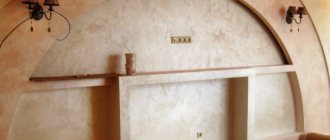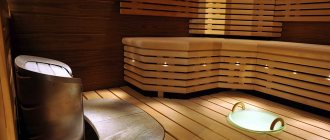Canopy and threshold in the house
The first thing a guest encountered when entering the house was the entryway. This is a kind of zone between the heated room and the street. All the cold was retained in the hallway and did not enter the main room . The canopy was used by the Slavs for economic purposes. The rocker and other things were kept in this room. a storage room in the entryway . This is a room that was separated from the entryway by a partition. It contained a chest with flour, eggs and other products .
The heated room and the canopy were separated by a door and a high threshold. This threshold was made to make it more difficult for cold air to penetrate into a warm room. In addition, there was a tradition according to which the guest, upon entering the room, had to bow, greeting the owners and the brownie . The high threshold “forced” the guests to bow down when entering the main part of the house. Since entry without bowing was ensured by hitting the head on the doorframe. With the advent of Christianity in Russia, bowing to the brownie and the owners was supplemented by making the sign of the cross and bowing to the icons in the red corner .
Where was the stove installed in a Russian hut?
Stepping over the threshold, the guest found himself in the main room of the hut. The first thing that caught my eye was the stove. It was located immediately to the left or right of the door . The Russian stove is the main element of the hut. The absence of a stove indicates that the building is non-residential. And the Russian hut got its name precisely because of the stove, which allows you to heat the room. Another important function of this device is cooking . There is still no healthier way to cook food than in the oven. Currently, there are various steamers that allow you to preserve the maximum of useful elements in food. But all this is not comparable to food cooked from the stove. There are many beliefs associated with the stove. For example, it was believed that it was a favorite vacation spot for the brownie. Or, when a child lost a baby tooth, he was taught to throw the tooth under the stove and say:
“Mouse, mouse, you have a turnip tooth, and you give me a bone tooth.”
It was also believed that garbage from the house should be burned in a stove so that the energy does not go outside, but remains indoors.
The image of a Russian hut in a modern interior
The road beyond the river got lost,
Lost in the forest side.
Goodbye, iron stove,
Warming childhood in a dream.
The road behind the river got lost, Lost in the forest side. Goodbye, iron stove, Warming childhood in a dream. Despite the fact that the hut already existed in the 9th century, it cannot be considered a primitive building. [1, p.87] Russian peasant houses were built of wood, they were spacious, with low ceilings. Parallel and perpendicular lines in the buildings made them, according to I. Futuan, more modern than primitive. [2, p.66] This approach corresponds to the well-known definition of Robert Redfield, who considered the “peasant world” as a transitional stage from a primitive community to a modern city. [3, p.26]
The farmhouse was constantly changed between 1880 and 1930. But despite all these changes, it was strikingly different from a modern apartment building. Customs and traditions played a primary role in the construction of houses. Regardless of who built the hut, the peasant always knew exactly what it should be like. Russian peasants built houses mainly from wood, which they “mined” from the surrounding forests. By 1900, the peasant's idea of a good home included more than just a hut. Unheated canopies began to be added almost everywhere. The heat source was a traditional Russian stove. [4, p.9] In the hut, the old-timers installed one stove, intended for both heating and cooking - a bread oven, which was located in the corner of the hut, to the left or right of the entrance.
This did not exclude the installation of additional stoves, but they were used only for heating. The mouth (“chelo”, “tselo”, “sa/ya/lo”) of the bread oven was facing the wall opposite the entrance and was illuminated by a side window. The stove stood almost close to the side wall. There was 20–30 cm between them, where kitchen utensils were stored - grips, a stick (poker), a broom (a broom made of pine paws), etc. Between the stove and the end wall, above the entrance, wooden floors were installed. A similar layout can be classified as North-Central Russian. In cross houses and five-walled houses with a truss, the stove was located so that it was possible to heat either all the rooms or several of them. In this case, they made a stove with a firebox or fireplace. The old-timers' hut was divided into various parts, which had their own names and semantic load associated with the purpose and equipment located there.
The significance of the hut space increased from the entrance to the opposite wall, where the “front corner” with icons and a table was located. The least honorable place was the part of the hut near the entrance, located between the bed and the stove - “under the threshold.” The space between the stove and the wall, where the “front corner” was located, was called “kut” by the old-timers. It traditionally belonged to a woman and was intended mainly for cooking and sewing. There was a “box” with the owner’s things - a chest with a dowry taken from her parents’ house.
Near the stove there was an entrance to the underground - a “golbets”. Adjacent to the stove on the side of the front door was a small bench called a “golbchik” [4, p.13]. Many people are increasingly attracted to traditional values, and the desire to furnish their homes in accordance with the latest fashion trends is giving way to turning to the roots. The style of the original Russian hut is reminiscent of rustic style in the interior and eco-style at once. It begins, naturally, with wood - this material fills almost the entire room. The historically correct option is log cabins, which are also complemented by finishing with boards with an aged effect on the walls, floor and ceiling. Plastic windows are replaced with wooden frames, preferably with swing shutters. Floors can be covered with homespun carpets or runners. The ceiling, made of thin logs or half-logs, appeared in Russian huts only in the 18th century. Before this, the interior space of the hut went right under the roof. When firing stoves “black,” the ceiling was simply not needed, since the smoke would only accumulate under it.
Ceilings began to be made only by heating the hut “in white” (through a pipe in the stove), while the ceiling covering was laid on thick beams. The Russian Izba interior style involves the use of brightly painted elements in the form of floral patterns on the ceiling. The Russian stove occupies a special place in the modern interior of country houses and even apartments. It becomes the central element zoning the space, and also brings semantic and spiritual content to the interior. Functionally, it also combines a stove, beds, a fireplace and decoration.
All elements of a Russian hut can remain in their original form or be transformed, supplemented with new materials, textures and even meaning. The good thing about ethno style in the interior is that it is not necessary to radically remodel the space of your home. You can get by with a selection of natural materials and certain forms inherent in the national style, or use folklore motifs in the decor.
Literature:
1. E.E. Blomkvist. Peasant buildings of Russians, Ukrainians and Belarusians (settlements, dwellings and outbuildings) / East Slavic ethnographic collection. Proceedings of the Institute named after. Miklouho-Maclay, new series, volume 31.M., 1956, p.82.
2. I.V. Makovetsky. Architecture of Russian housing. M.: Publishing House of the USSR Academy of Sciences, 1962, p.66.
3. Rural housing / ed. A.N. Sysina, M., 1928, p. 26.
4. W.K. Broomfield and Blair Ruble. Housing in Russia: XX century Architecture and social history. M. 2002, p.9.
MAGAZINE: SCIENCE TIME 2020. No. 5 (17). pp. 483-485.
Author: Udalova Nadezhda Nikolaevna member of the Union of Designers of Russia
All the best, beaver and cozy huts
Red corner in a Russian hut
The red corner is an integral part of the interior decoration of a Russian hut . It was located diagonally from the stove (most often this place fell on the eastern part of the house - a note to those who do not know where to install the red corner in a modern home). It was a sacred place where towels, icons, faces of ancestors and divine books were located. A necessary part of the red corner was the table. It was in this corner that our ancestors ate food. The table was considered a kind of altar on which there was always bread:
“Bread on the table, so the table is a throne, but not a piece of bread, so the table is a board.”
Therefore, even today tradition does not allow sitting on the table. Leaving knives and spoons behind is considered a bad omen. To this day, another belief associated with the table has survived: young people were forbidden to sit on the corner of the table in order to avoid the fate of celibacy.
The most beautiful Russian huts
One of the symbols of Russia, which, without exaggeration, the whole world admires, is the wooden hut. Indeed, some of them amaze with their incredible beauty and uniqueness. About the most unusual wooden houses - in the review of “My Planet”.
Where: Sverdlovsk region, Kunara village
In the small village of Kunara, located 20 km from Nevyansk, there is a fabulous tower, recognized in 1999 at a competition of homemade wooden architecture as the best in our country. The building, reminiscent of a large gingerbread house from a fairy tale, was created by hand by a single person - blacksmith Sergei Kirillov. He created this beauty for 13 years - from 1954 to 1967. All decorations on the facade of the Gingerbread House are made of wood and metal. And children holding posters in their hands with the inscriptions: “Let there always be sun...”, “Fly, doves, fly...”, “Let there always be mother...”, and rockets ready to soar up, and riders on horses, and the sun, and heroes, and symbols of the USSR... And also many different curls and unusual colors. Anyone can enter the courtyard and admire the man-made miracle: Kirillov’s widow does not lock the gate.
Where: Smolensk region, Flenovo village, historical and architectural complex “Teremok”
This historical and architectural complex includes four buildings that previously belonged to the famous philanthropist Maria Tenisheva. The Main Estate, created in 1902 according to the design of Sergei Malyutin, deserves special attention. This carved fairy-tale mansion is a real masterpiece of Russian small architecture. On the main facade of the house there is an incredibly beautiful window. In the center, above the carved frames, the Firebird with a flirtatious crest sat down to rest, and on both sides of her graceful skates reared up. The wonderful animals are warmed by the carved sun with its rays, and the ornate fairy-tale patterns of flowers, waves and other curls amaze with their fantastic airiness. The log frame of the tower is supported by green scaly mountain snakes, and two months are located under the roof arch. On the window on the other side is the Swan Princess, “floating” on wooden waves under a carved sky with the Moon, month and stars. Everything in Flenovo was decorated in this style at one time. It’s a pity that this beauty was preserved only in photographs.
Where: Irkutsk, st. Friedrich Engels, 21
Today's House of Europe is the former estate of the Shastin merchants. This house is one of the calling cards of Irkutsk. It was built in the middle of the 19th century, but only in 1907 it was decorated with carvings and nicknamed Lace. Openwork wooden decorations, elegant patterns of the facade and windows, amazingly beautiful turrets, complex outlines of the roof, curly wooden columns, relief carvings of shutters and trim make this mansion completely unique. All decorative elements were cut out by hand, without patterns or templates.
Where: Karelia, Medvezhyegorsky district, o. Kizhi, Museum-Reserve of Wooden Architecture "Kizhi"
This two-story house, similar to a richly decorated tower, was built in the village of Oshevnevo in the second half of the 19th century. Later he was transported to about. Kizhi from the Big Klimets Island. Under one large wooden hut there were both residential and utility premises: this type of construction developed in the North in the old days due to the harsh winters and the peculiarities of the life of local peasants. The interiors of the house were recreated in the mid-20th century. They represent the traditional decoration of the home of a wealthy peasant of the North at the end of the 19th century. Massive wooden benches stretched along the walls of the hut, above them there were voronsky shelves, and in the corner there was a large bed. And of course, the obligatory oven. Authentic things of that time are also kept here: clay and wooden dishes, birch bark and copper items, children's toys (a horse, a sleigh, a loom). In the upper room you can see a sofa, a sideboard, chairs and a table made by local craftsmen, a bed, a mirror: ordinary everyday items. From the outside, the house looks very elegant: it is surrounded by galleries on three sides, there are carved frames on the windows... The design of the three balconies is completely different: a turned baluster serves as a fencing for the western and southern balconies, while the northern one has an entirely openwork design of flat gorges. The decor of the facades is distinguished by a combination of saw-cut and volumetric carvings. And the combination of oval protrusions and rectangular teeth is a characteristic technique for “cutting” patterns in the Zaonezhye regions.
Where: Moscow, Pogodinskaya st., 12a
There are very few old wooden houses left in Moscow. But in Khamovniki, among the stone buildings, stands a historical building, built in the traditions of Russian wooden architecture in 1856. Pogodinskaya hut is a wooden frame of the famous Russian historian Mikhail Petrovich Pogodin.
This tall log house, made of high-quality logs, was built by the architect N.V. Nikitin and presented to Pogodin by entrepreneur V.A. Kokorev. The gable roof of the old house is decorated with a wooden carved pattern - saw carvings. Window shutters, “towels”, “valances” and other details of the hut are also decorated with wooden lace. And the bright blue color of the building, coupled with snow-white decorations, makes it look like a house from some old Russian fairy tale. But the present at the Pogodinskaya hut is not at all fabulous - now the house houses offices.
Where: Irkutsk, st. December Events, 112
The city estate of V.P. Sukachev was created in 1882. Surprisingly, over the years, the historical integrity of this structure, its amazing beauty, and even most of the adjacent parkland have remained virtually unchanged. The log house with a hipped roof is decorated with saw-cut carvings: figures of dragons, fantastic stylized images of flowers, complex weaves of the fence on the porch, balks, cornice belts - everything speaks of the rich imagination of Siberian craftsmen and is somewhat reminiscent of oriental ornaments. Actually, the oriental motifs in the design of the estate are quite understandable: at that time, cultural and economic ties with China and Mongolia were developing, which influenced the artistic taste of Siberian craftsmen. Nowadays, the estate has not only retained its magnificent appearance and amazing atmosphere, but also lives a fairly eventful life. There are often concerts, musical and literary evenings, balls and master classes for young guests in modeling, drawing, and making patchwork dolls.
Shop with a chest in a hut
Everyday objects in a Russian hut played their own role. A hiding place or chest for clothes was an important element of the house. Skrynya was inherited from mother to daughter . It included the girl’s dowry, which she received after marriage. This element of the interior of a Russian hut was most often located next to the stove.
Benches were also an important element of the interior of a Russian hut. Conventionally, they were divided into several types:
- long - different from the others in length. It was considered a women's place where they did embroidery, knitting, etc.
- short - men sat on it during meals.
- kutnaya - installed near the stove. Buckets of water, shelves for dishes, and pots were placed on it.
- threshold - walked along the wall where the door is located. Used as a kitchen table.
- ship - a bench higher than others. Intended for storing shelves with dishes and pots.
- konik - a square-shaped men's shop with a carved horse's head on the side. It was located near the door. Men were engaged in small crafts there, so tools were stored under the bench.
- The "beggar" was also located at the door. Any guest who entered the hut without the permission of the owners could sit on it. This is due to the fact that the guest cannot enter the hut further than the matitsa (a log that serves as the basis for the ceiling). Visually, the matica looks like a protruding log across the main laid boards on the ceiling.
The upper room is another living space in the hut. Wealthy peasants had it, because not everyone could afford such a room. The upper room was most often located on the second floor . Hence its name, the upper room - “mountain” . It contained another oven called a Dutch oven. This is a round oven. In many village houses they still stand as decoration. Although even today you can find huts that are heated by these ancient appliances.
Enough has already been said about the stove. But we cannot fail to mention those tools that were used in working with Russian stoves. The poker is the most famous item. It is an iron rod with a curved end. A poker was used to stir and rake coals . The broom was used to clean the stove from coals .
With the help of a grabber it was possible to drag or move pots and cast iron pots. It was a metal arc that made it possible to grab the pot and move it from place to place. The grip made it possible to place the cast iron in the oven without fear of getting burned .
Another item used in working with the stove is a bread shovel . With its help, bread is placed in the oven and taken out after cooking. But not many people know chaplea This tool is otherwise called a frying pan. It was used to grip a frying pan .
Russian hut. Interior and structure
Since ancient times, a wooden hut has been the place of residence of every ordinary Russian person. Such houses, built from wooden planks (or solid logs), began to be built during the existence of Kievan Rus. Until now, many connoisseurs of antiquity build similar homes for themselves. Unlike stone architectural monuments, the most ancient huts have not survived to this day, however, as a good example, we got houses built in the 19th century. Looking at them, you can determine the life of that time, the interior, and other features of former life.
The shape of such buildings is extremely simple - a square or rectangle. This geometric precision is maintained inside the structure, even if it is divided into several different rooms. It is thanks to this architectural technique that a unique atmosphere of comfort and warmth is created, which only a Russian hut can boast of. The interior, as a rule, was simple. The dwelling consisted of several rooms, including a room, a vestibule, a cage and a closet. In some huts, a basement, porch and attic were also built - everything depended on the wealth of the owner.
As a rule, you can immediately understand from the surrounding objects and their arrangement that this is a Russian hut. The interior is distinguished by rigor, conciseness and minimalism. An indispensable attribute of an old hut were long benches that were nailed to the walls or to the floor. Near them there could be a long dining table. All household items, dishes and belongings were located on hanging shelves that were nailed to the walls. Some houses had a sideboard, but this is far from a necessary detail, especially if the living space is small. After all, space is the main criterion that should characterize a Russian hut.
The interior of the old village houses was undoubtedly complemented by a stove. It was located in the center of the living space, and around it there were tables, shelves and hooks on which pokers, ladle, pots and pots with handles were hung. A cradle was often placed on the back of the stove, in which it was warm to sleep, especially in the winter cold. This is exactly how the Russian hut is presented in many of our fairy tales.
The interior of peasant houses of bygone centuries was lavishly decorated with various accessories and paintings. As a rule, stoves, tables and benches, shelves, dishes and window frames were painted with national ornaments. Such drawings were based on images of the sun, Kolovrat and geometric patterns in red, yellow and black tones. Painted plates and pots were placed on shelves, and they became a worthy addition to the overall ensemble.
If you want to create an interior in the style of a Russian hut in your home, you will have to start with the interior decoration of the walls. They should be made of logs or boards, preferably pine trees. Order wooden furniture in a characteristic style from the manufacturer, and then you can paint it yourself if you have a brush.
You can see the interior of a Russian hut in pictures in the article and, starting from them, recreate something of your own. It is not so difficult to embody past traditions, given the variety of modern materials and the imagination of designers.
Cradle in a hut
The cradle in Rus' had various forms. There were hollowed out ones, wicker ones, hanging ones, and “vanka-standers”. Their names were surprisingly varied: cradle, shaky, coli, rocking chair, cradle. But a number of traditions are associated with the cradle, which remained unchanged. For example, it was considered necessary to install the cradle in a place where the baby could watch the sunrise . Rocking an empty cradle was considered a bad omen. We still believe in these and many other beliefs to this day. After all, all the traditions of their ancestors were based on their personal experience, which the new generation adopted from their ancestors.











